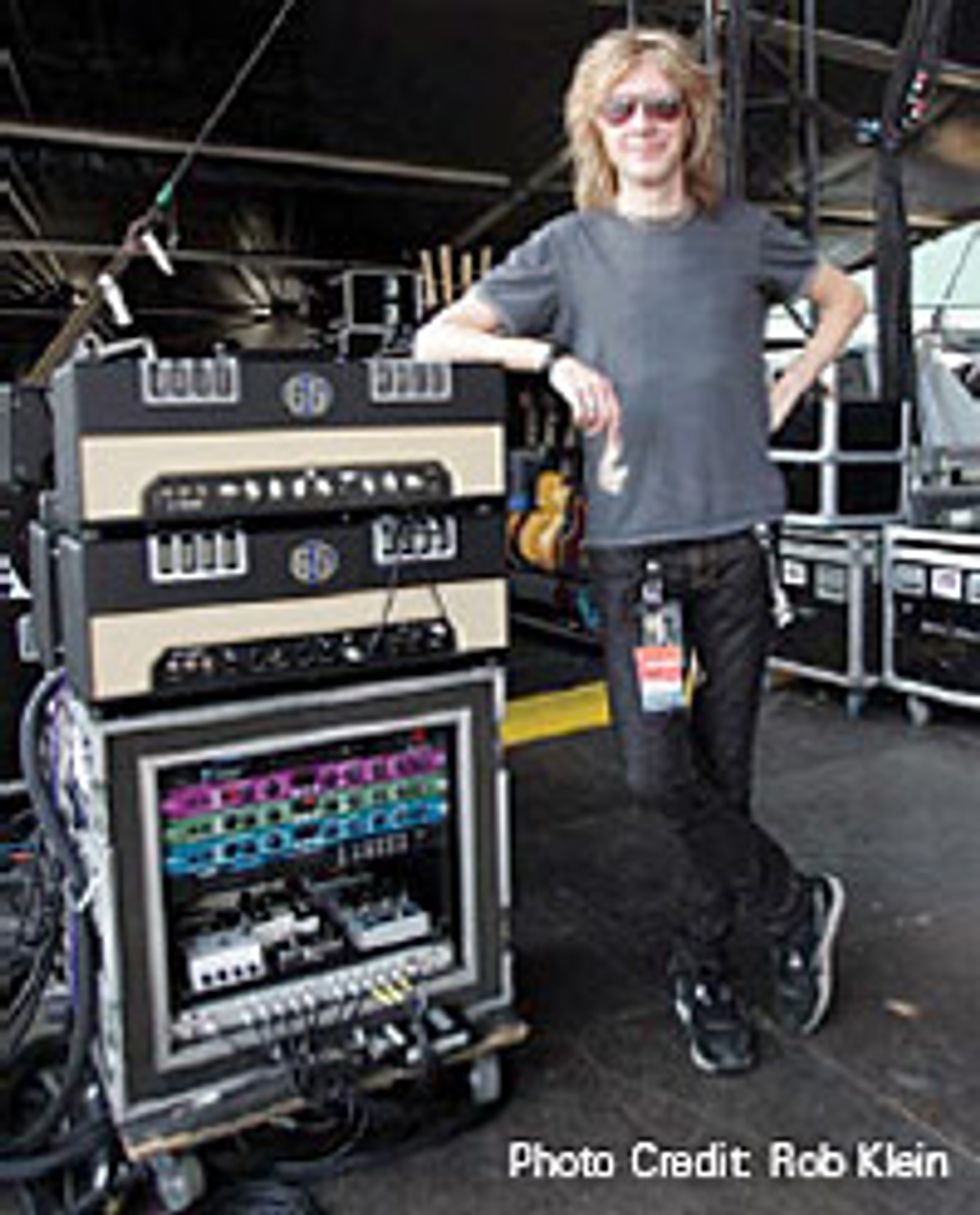In the past I could get away with a pedalboard and a couple of amps, but as the songs and our production became more elaborate with more guitar parts to be covered I found myself doing a bit of an Irish jig trying to hit all of the switches on cue. So I succumbed to … THE RACK
 I’m back out with Sheryl Crow this month for a handful of private engagements, so I thought I’d finally get around to showing off my touring amp and effects rig.
I’m back out with Sheryl Crow this month for a handful of private engagements, so I thought I’d finally get around to showing off my touring amp and effects rig. In the past I could get away with a pedalboard and a couple of amps, but as the songs and our production became more elaborate with more guitar parts to be covered I found myself doing a bit of an Irish jig trying to hit all of the switches on cue. So I succumbed to … THE RACK (cue evil music). I had issues with going the way of the rack because, for me, it epitomized the over-processed, sterile ‘80s guitar sound; having a refrigerator full of digital delays and other processors recreating the sound track to Flashdance.
There was also the intimidating task of programming the rig. What if it goes down? Am I screwed? At least with a pedalboard you can trace the cables if your signal goes out or set up a bypass, feeding the signal straight into the amp. But the big advantage to the rack I couldn’t deny was the programming flexibility afforded by the MIDI switching. I found a few cool ideas, but nothing that made me feel secure about placing my gig livelihood in the hands of MIDI. All I could picture was hitting a patch, getting no sound and standing there on stage with my pants down to my ankles.
The entire time, my tech, Andy Wolf, and Sheryl’s tech, Rick Purcell, kept advising me to go the way of the Bob Bradshaw/CAE switching system. They even borrowed Lyle Workman’s Bradshaw system, bringing it to our rehearsal to substantiate their claims that it was the way to go. I finally gave in to their guidance and they proceeded with Bob in designing a system.
I still wanted to incorporate my favorite pedals, but also use the Line 6 Modeling PRO programmable rack units that had become available at the time – this was back in 2003, Line 6 no longer offers these rack units. We decided on the Line 6 PRO Delay, Modulation and Filter units, one drawer full of pedals and the Bradshaw switching system, which would send the signal to up to four guitar amps individually or combined, along with a D.I. for acoustic.
Tour rehearsals continued, and I suffered along with the pedalboard, until the glorious day that the rack unit arrived. Andy spent an entire weekend retrofitting the pedals to the Bradshaw system, wiring it up and beginning the initial programming. As elaborate as the rig looks, its function is really quite simple. My guitar plugs straight into the front of the Bradshaw switching unit, a single space rack mount device built to our specific requirements, based on how many amps and effects I’ll be programming and switching between. From there the signal gets routed either directly to one or more guitar amplifiers or through a series of effects first, then to the amps.
At the time (pre-65amps), I wanted to use my favorite vintage amplifiers in different combinations. I prefer running the effects into the front input of the amps, as opposed to having an effects loop between the preamp and power amp stages. With the Bradshaw system, if I’m only using one effects pedal on a patch, then the signal goes through only that effect, not through the entire chain. It “inserts” the effect when you tell it to do so. The signal then goes to the amplifier outputs. Each effects loop has a buffer amplifier to regain any signal lost from cable resistance or the effects pedal. Also, each amplifier output on the switcher has a high quality Jensen iso-transformer that breaks the ground at input level between multiple guitar amplifiers. This gets rid of any AC ground loop hum between amps.
The end result is the clearest, purest and quietest sounding rig I’ve ever owned. Even when switching in the wah pedal, which is connected to a switching loop with 80 feet of cable running out front, there is no signal loss or noise. Absolutely incredible.
I’m using the same rig to this day, switching out a few pedals here and there. The system has not failed once. Since I’ve used up this month’s column space talking about it, I’ll walk you through the setup with pictures and descriptions next month.
Until then...cheers!
Peter Stroud
65amps/co-founder
www.sherylcrow.com
65amps.com
